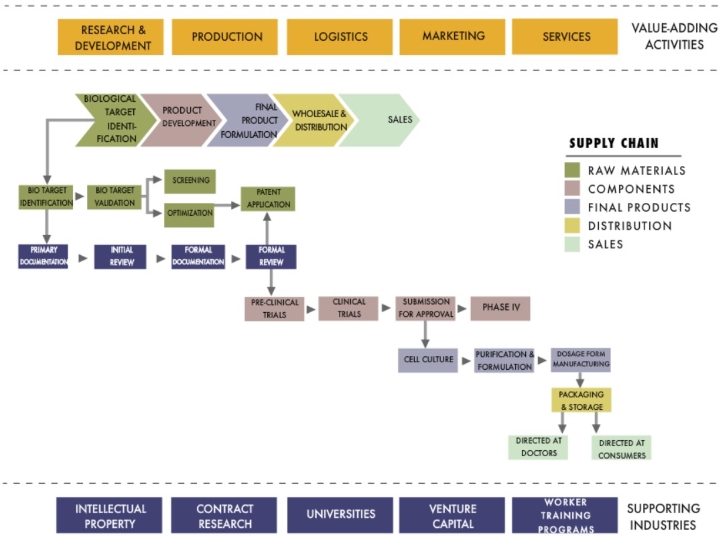Value Chain (2012)
Drugs & Pharmaceutical Biotechnology Value Chain 2012

Value Chain Description
Broadly defined as a collection of tools and technologies that use living cells and their molecules to make products and solve systems, biotechnology as an industry has a wide range of applications. Such diversity then creates a wide array of slightly, and/or, vastly different value chain maps. Since a majority of the work currently done in North Carolina is based in the research, product development, and manufacturing of pharmaceutical applications, these areas are the focus of the value chain pictured above.
Biotechnology development is a costly and long-term process that involves ethical issues, government policy, complicated business development, investors, extended periods for development and testing, and typically large sums of money. Thus, the biotech GVC incorporates numerous actors that require coordination of operations to bring a product from inception to final commercial delivery. North Carolina’s development of its Research Triangle Park has proven to be a very successful example of industrial clustering that has helped promote collective efficiency gains through a geographic agglomeration of related and ancillary firms. A low cost of doing business, high quality of life, excellent universities, and long-term commitment from public and private actors continue to make North Carolina a globally competitive leader in biotechnology; especially with respect to discovery, product development, and manufacturing. Many companies choose to operate in NC because of its research university network, the workforce training the state offers, and the high concentration of contract research organizations (CROs) – the industry’s primary form of R&D outsourcing. All of these factors support and add to North Carolina’s very high levels of global biotech competitiveness.
Introduction to NCGE Value Chains
Value Chains on the North Carolina in the Global Economy (NCGE)
What is a value chain?
A value chain describes the full range of activities that firms and workers carry out to bring a product or service from its conception to its end use and beyond. This includes activities such as design, production, marketing, distribution and support to the final consumer. The activities that comprise a value chain can be contained within a single firm or divided among different firms and can be contained within a single geographical location or spread over wider areas. For additional background on the origins and research associated with this concept, see the Duke-hosted website, www.globalvaluechains.org.
Value Chain Dimensions
Each industry value chain is composed of three dimensions that work together to produce final products and services for the market. These include:
Value-Added Activities: Value is created in products and services via a series of six steps: research & development, design, production, logistics, marketing and services. Each of these varies in importance based on the industry. In the visual depictions, the top line is composed of the most important value-adding activities for each industry. When you hover the cursor over any “value-adding activities” box information on the activity and its connection to the supply chain appear.
Supply Chain: Each industry has an input-output process that begins with raw materials and continues through the making of components and final products, and finally to distribution and sales. In the value chain visuals, the supply chain is broken into five colors; each representing of the basic stages. When you place your cursor over these boxes, a description of each activity appears along with statistics (based on NAICS codes) on the number of firms, employees and average annual wages per employee in North Carolina (see the Website Overview for information on NAICS codes). The arrows represent the main stages and the boxes listed below represent specific types of products, processes or markets.
Supporting Industries: The supporting environment includes the entities that support and influence actors in the supply chain such as trade and professional associations, government agencies, testing and training facilities, community colleges and universities as well as material and machinery providers. The entities present in North Carolina are located along the bottom row of the visual. When you hover the mouse over these boxes the supply chain stages impacted by the supporting industry is highlighted and statistics or descriptive text is displayed when available.
